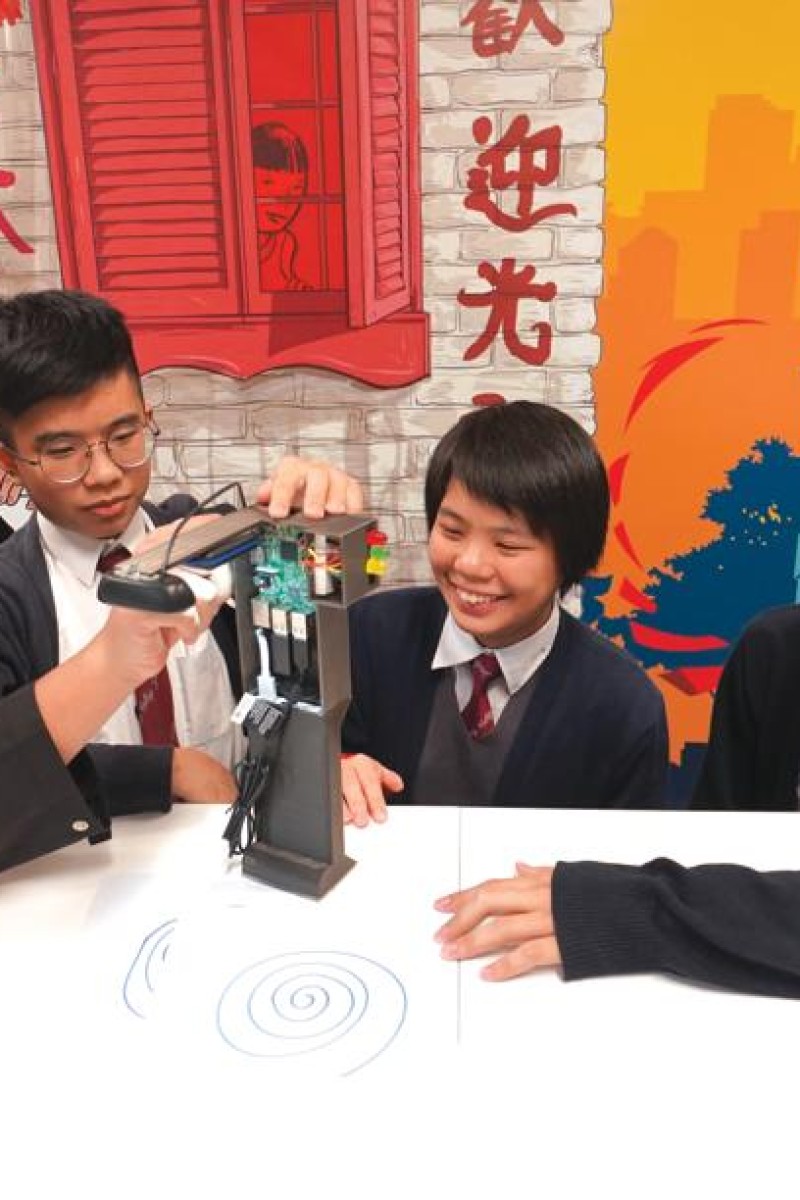
Speedy detection test for Parkinson’s developed by Hong Kong students
Raspberry Pi-powered device analyses hand-drawn spirals to detect signs of the disease using the power of artificial intelligence
 Team members (from left) Umar, Peter, Paula, Samuel won an award at the 2019 HSBC Smart Community Hackathon.
Team members (from left) Umar, Peter, Paula, Samuel won an award at the 2019 HSBC Smart Community Hackathon. From a simple drawing of a spiral or a wave, these four local senior secondary students can tell you something about your health in less than 20 seconds.
Sixteen-year-olds Paula Tsang Pui-ki, Peter Chau Choi-man and Umar Abas, and 17-year- old Samuel Fu Yan-chak, are the masterminds behind the Fast Parkinson’s Detector.
With just the press of a button, their device – built using 3D printing and no bigger than a study lamp – identifies whether you have the neurodegenerative disease using artificial intelligence – with 80 per cent accuracy.
The Church of Christ in China Yenching College students make up one of the five winning teams of the HSBC Hong Kong Community Partnership Programme 2019’s Smart Community Hackathon, a competition which invites secondary students to use their Stem knowledge to improve the health of the community.
“A few of our peers were worried because their elderly family members were showing symptoms of Parkinson’s disease, and they were uncertain about it. Their shared concern inspired us to invent the device,” team leader Paula told Young Post.
The group’s initial research suggested that spirals or waves drawn by people with Parkinson’s disease are less smooth than those drawn by healthy individuals because of their tremors. To help his team develop AI software capable of processing photographs of hand-drawn spirals and waves, Samuel turned his hand to computer programming, using code samples he found online to write the software.
To enable the programme to use drawings to determine whether an individual has Parkinson’s, two sets of data were required: a set of images to train the machine learning model, and another set for optimising the algorithm.
“We gathered a total of 200 images of hand-drawn spirals and waves online [from related studies] to increase the programme’s accuracy,” Samuel said.
Teaching the computer to do its job was a tricky process though, he admitted. “I had to adjust the AI programme’s parameters through trial and error until the programme could make the correct prediction,” he added.
At the early development stage, the programme had to be run on a laptop, which means it was separate from the physical device. But after the quartet had been shortlisted as one of the 20 finalists and were given a HK$5,000 grant, they were able to combine the two by installing a Raspberry Pi – a palm-sized single-board computer – into their device.
The next best thing in technology
“We wanted to make our device more portable and lower its operating cost,” explains Samuel. “Running the programme on a laptop requires the presence of someone who knows how to operate it. That’s why we decided to simplify the process, so that the screening could be done by anyone with just the press of a button.
“To make the device more user-friendly, we also modified the device’s design by changing the power plug into a power bank,” added Umar, who was responsible for fine-tuning the physical device, while Samuel worked on the software.
However, when the team tried testing their device in their school computer room, they ran into another issue: its camera wasn’t always able to capture every single part of hand-drawn spirals, thereby reducing the accuracy of the results. After consulting their teacher in charge and making further observations, they realised the problem was related to insufficient or overexposure to light. To solve this problem they added an LED light to the device to ensure consistent lighting.
Coronavirus outbreak: Epidemic, pandemic, and other key terms about contagious diseases explained
Bringing home one of the three Community-friendly Awards, the team was proud to have transformed their idea into reality.
“I am very happy that our device could provide early screening to people suspected of having Parkinson’s disease, which could reduce the pressure on the public health-care system,” Peter said.
Looking ahead, Paula, Samuel, Peter and Umar plan to collect more samples of drawings by Parkinson’s patients in the local and international community to improve the accuracy of their device. The earlier Parkinson’s can be detected, the better, they said.
Cancer-sniffing dogs detect disease with sensitive sense of smell
“There are five different stages of Parkinson’s disease. We hope our data can eventually help us distinguish the differences in the hand-drawn images between patients of different stages,” Samuel said.
“Ultimately, we hope this device will be launched to help senior citizens,” added Paula.
“Most elderly only visit the doctor during the late stages of their Parkinson’s disease ... However, if our device were available at elderly homes or at hospitals, early detection and treatments would be possible.”
